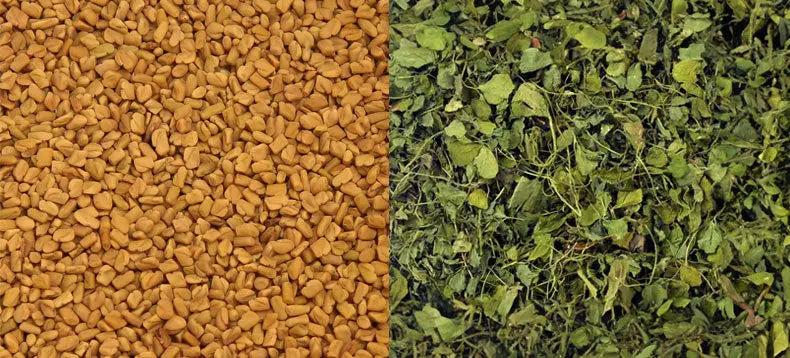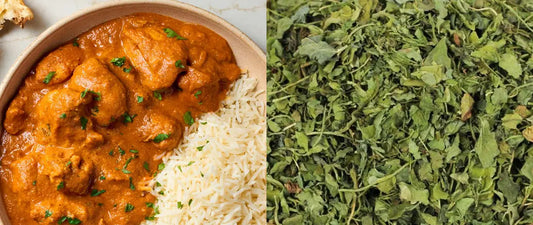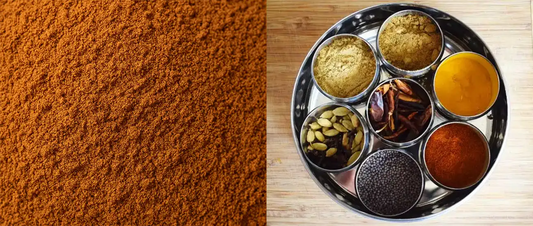
What is Kasoori Methi? Everything You Need to Know
Table of Contents
Kasoori Methi in English is Dried Fenugreek Leaves. It's a popular culinary herb widely used in Indian cooking. It is made by drying fresh fenugreek leaves, which are harvested from the fenugreek plant, scientifically known as Trigonella foenum-graecum. This herb boasts a strong aroma and a distinct flavour profile that adds depth to various dishes. Kasoori Methi has gained popularity not only in Indian cuisine but also in international kitchens due to its unique taste and versatility.
In this article, we'll dive into more detail about this herb. You'll learn about its flavour, health benefits, as well as tips on how to use it in your cooking, and possible alternatives. We'll provide advice on incorporating this herb into your dishes and share recipe ideas to help you make the most of it.

The History of Kasoori Methi
Kasoori methi originated in the Kasur region of Punjab, Pakistan. The soil and climate in this region are ideal for growing methi, and the resulting leaves have a unique flavour and aroma that is prized by chefs around the world.
After the partition of India in 1947, the Kasur region became part of Pakistan. However, methi growers in India quickly realised that they could produce methi of the same quality in other parts of Punjab, such as Malerkotla. Today, kasoori methi is also grown in Rajasthan, India, which borders Pakistan.
While the name "kasoori methi" technically refers to methi from Kasur, it is now used more generally to refer to any high-quality dried fenugreek leaves. Kasoori methi is a popular ingredient in Indian, Pakistani, and Middle Eastern cuisine.
The Flavour of Kasoori Methi
Kasoori Methi is renowned for its rich and earthy flavour, which is often described as a combination of bitter and sweet with a slight nutty undertone. The dried leaves offer a concentrated version of the fresh herb's taste, releasing a slightly pungent and aromatic scent when crushed or cooked. The flavour of Kasoori Methi adds complexity to dishes, making it a valuable ingredient in both vegetarian and non-vegetarian recipes.
The Health Benefits of Kasoori Methi
Apart from its culinary uses, Kasoori Methi also offers several potential health benefits. It is known to be rich in dietary fibre, vitamins, and minerals, including iron, potassium, and calcium. Some of the potential health benefits of Kasoori Methi include:
- Reduces blood sugar levels: Kasoori methi has been shown to help reduce blood sugar levels in people with diabetes. This is because it contains compounds that help the body to metabolise sugar more efficiently.
- Lowers cholesterol: Kasoori methi can help to lower cholesterol levels by reducing the absorption of cholesterol from food. It also contains compounds that help to break down cholesterol in the body.
- Boosts immunity: Kasoori methi is a good source of antioxidants, which can help to boost the immune system. It also contains compounds that have antibacterial and antifungal properties.
- Aids weight loss: Kasoori methi can help to promote weight loss by suppressing appetite and increasing metabolism.
Please note that we're not health professionals, and the information provided is solely based on research. We recommend consulting with a medical professional before making any changes to your diet or lifestyle.

How to Use Kasoori Methi in Cooking
Kasoori methi can be used in a variety of dishes, both savoury and sweet. It is a popular ingredient in Indian curries, dals, and sabzis. It can also be used to flavour rice, breads, and vegetables. Kasoori methi is often added to dishes towards the end of cooking, as its flavour can become bitter if cooked for too long.
To use kasoori methi in cooking, simply add a small handful of the leaves to the dish a few minutes before it is finished cooking. You can also crush the leaves before adding them to the dish, which will release more of their flavour.
- Curries and Gravies: Add a pinch or more of crushed Kasoori Methi while cooking curries, stews, and gravies for an extra layer of flavour. For example: Butter Chicken, Chicken Tikka Masala, Lamb Rogan Josh, Saag Paneer, Malai Kofta.
- Breads and Rotis: Incorporate Kasoori Methi into dough for making flavourful bread like methi paratha or use it as a topping for naan or other flatbreads. For example: Methi Paratha, Kulcha, Naan, Puri
- Vegetable Dishes: Sprinkle dried fenugreek leaves over cooked vegetable dishes, such as potatoes or paneer, to provide a distinct aroma and taste. For example: Aloo Methi, Bhindi Masala, Chawli Masala, Methi Mutter, Palak Paneer.
- Soups and Lentils: Enhance the taste of lentil dishes, soups, and broths by infusing them with the fragrance of Kasoori Methi. For example: Dal Makhani, Masoor Dal, Chana Masala, Kadhi Pakora.
- Marinades and Sauces: Mix Kasoori Methi into marinades or sauces for meats, poultry, or seafood to give them a unique flavour twist. For example: Tandoori Marinade, Curry Sauce, Chutney.
Learn more about proper spice storage techniques to maintain Kasoori Methi's freshness.

Kasoori Methi Substitute/Alternatives
If you don’t have kasoori methi on hand, there are a few substitutes that you can use. Some good substitutes for kasoori methi include:
- Fresh Fenugreek Leaves: If available, use fresh fenugreek leaves in the same quantity as dried leaves. Keep in mind that fresh leaves have a milder flavour.
- Fennel Leaves: Fennel leaves share a similar aroma and can be used as an alternative, although the flavour profile is not an exact match.
- Celery Leaves: Celery leaves offer a mild herbal flavour and can be used in smaller quantities to substitute for Kasoori Methi.
- Mustard Greens: Mustard greens can bring a slightly peppery taste and are a reasonable alternative in some dishes.
Remember that while these alternatives can provide similar aromatic qualities, they might not perfectly replicate the unique flavour of Kasoori Methi.
Read more: 10 Must-Have Indian Spices for Your Kitchen.
Frequently Asked Questions
- How much Kasoori Methi should I use in my curry? Use 1-2 teaspoons for curries serving 4-6 people. Add it in the last 2-3 minutes of cooking to preserve the flavour. Start with less and adjust to taste - a little goes a long way!
- Can I use this if I can't find it in local stores? Yes! We deliver fresh, authentic Kasoori Methi Australia-wide from Brisbane. No need to settle for stale supermarket versions or empty shelves - get premium quality delivered to your door.
- How long does Kasoori Methi stay fresh? 12-18 months when stored in an airtight container away from light and moisture. It's still fresh if it has a strong, earthy aroma when crushed between your fingers.
- Is your Kasoori Methi authentic Indian quality? Absolutely. We source directly from India and import regularly in small batches for maximum freshness. Same quality used in authentic Indian kitchens.
Conclusion
I hope this article has helped you learn more about Kasoori Methi and how to use it when you're cooking. Try it out in different dishes and see what you think! If you want to buy kasoori methi or other spices, you can get them from our online store.
About True Indian Spices
We're a small family-run business based in Brisbane, bringing authentic Indian spices straight to Australian kitchens. Our family migrated here in 1995, and we've been passionate about sharing rich Indian flavours ever since.
We work directly with trusted suppliers in India to source the freshest, highest-quality spices for home cooks across Australia, helping you create delicious, authentic meals whether you're just starting out or already a pro.
📍 Location: Sunnybank, Brisbane QLD 4109
📞 Contact: 07 3067 0641
✉️ Email: info@trueindianspices.com.au
🏢 ABN: 48 613 515 365


